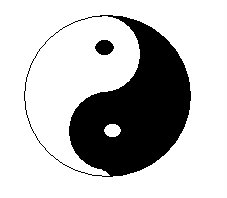
Occupying the Centre (Part III)
Continued from Part 2 .........
It is said that the Taiji symbol comprises of 2 fish. One in white, representing yang, the positive force; the other one in black, representing yin, the negative force.

Picture drawn by
Gogo Tsang
It looks as if the white fish is chasing the black fish, and vice versa.
What does this mean?
It means that Yin and Yang are interrelated. In their extreme forms, the Yin force will transform into the Yang force and the Yang force will transform into the Yin force.
Imagine you stand firm on the ground and use all your strength to push forward. In a normal situation, you will choose the best body position in order to exercise your strength effectively. You are then in a balance position. But if you try to extend your hands and / or body a little bit forward without moving your feet, your strength will decrease as soon as your balance position is altered. Instead of increasing your strength, the extension decreases it. Your Yang force is transforming into Yin force. This is of course only a crude example to help you appreciate the mechanism involves. Obviously, the other party will not do an own goal to unbalance himself. Martial art involves the interaction between 2 human bodies. The transfer of power between 2 persons is more complicated.
Transformation from Yin to Yang requires special technicality. This is not just an increase of force from within a practitioner's own body. Whilst a taiji practitioner is able to exercise powerful internal strength after completing the traditional trainings as explained previously, this is not the flower of the art. Taijiquan emphasises balance, coordination of mind and body and not to use brutish strength. Facing an attack, a taiji practitioner will not use brutish strength to counter-act. In response to a powerful attack, a taiji practitioner merges the Yang (positive) force of the other party with his own force, and then directs the force as merged to such a way that it serves to enhance the momentum of the taiji practitioner, who, as a result of the enhanced momentum, will then be in a position to transmit force with destructive power.
This is what people usually called the "borrowing of power" from the other party.
The follow up questions are:
1. How to trigger off the merger and the conversion?
2. What's the nature of the force exercised by a taiji practitioner in the force merging process?
The secret is in the fish.
(Links for Part 1 , Part 2 , Part 4 , Part 5, Part 6 and Part 7)




No comments:
Post a Comment